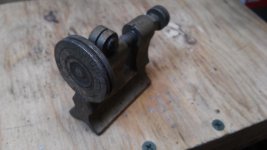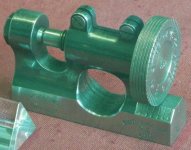Don't know about the SteveM's. I"m guessing it's not entirely ancient and more along the lines of the W.Fox & Sons micrometer I once had. Asquith's with it's bright green finish maybe a later version of my still-late version?? Hard to read the info below (screenshot of a catalog) but it IS for gauging things like rolled steel and was made after WWII up to about 1980.
What puzzles me about the OP's is the mix of what look like shop made and more refined elements. There's a hex nut to lock the anvil, what looks to be a saw cut for the thread adjustment that also cut into the anvil area (where it need not be), and what looks like a crudely cut throat. But the graduated dial at the back looks like someone took some care to decorate.






